Call of Duty: Vanguard review - a lot better than expected, but nothing you haven't seen before
Three distinct game modes vary so much in quality - this is the most up and down Call of Duty in years.
As sure as the sun rises every morning, Activision will release a Call of Duty game every year. Come hell, high water, or world-ending pandemic – you can count on a new entry into the biggest shooter franchise in gaming to entertain you in November or thereabouts.
This year’s unusual release is Sledgehammer Games’ Vanguard, the studio’s second World War 2 game in a row after 2017’s Call of Duty: WW2. If you’re keeping up with the series’ three-year development cycle, you’ll know that it was actually Sledgehammer’s turn last year to deliver a game, which it had been working on alongside Raven, but disagreements between the two over design direction reportedly forced Activision to bring in Treyarch to salvage what’s left and bring us last year’s Black Ops Cold War.
Presumably, all this forced Sledgehammer’s hand in deciding what game to work on next, even if everyone knew it was too early to bring back the WW2 era. With all that strife in mind, and after the less-than-stellar beta, everyone – myself included – was bracing for a middling-to-bad one of those.
To my surprise, Vanguard is one the more polished, and content-rich CoDs in general, even if much of that won’t excite or move you one way or another, beyond offering adequate bursts of fun while you wait for more interesting games to come out.
Campaign
Vanguard’s campaign is one of the safest, most straightforward affairs I’ve seen from Call of Duty. Whereas last year’s Black Ops Cold War at least introduced an interesting shift in structure, with puzzle-solving, multiple endings, and a particular mission that felt like it came out of Hitman, this year’s romp is a predictable story about how war turns ordinary people into fighters. At least, that’s the only theme I could see running through it.
The story doesn’t so much revolve around a main plot; it almost feels like expanded, playable introductory cutscenes for Vanguard’s multiplayer characters. The vast majority of the campaign’s missions are flashbacks setting up the main heroes, each of whom comes from a different theatre of WW2 – all recruited to join a first-of-its-kind special forces unit that’s meant to achieve what big platoons cannot.
So, we spend the entirety of it essentially playing a day, or two, in the life of one of those people, and how they came to hate Nazis, but not quite why/how they joined this elite unit – beyond an off-hand comment that their file ended up on the leader’s desk. The missions themselves don’t attempt to do anything interesting with the AI or invent new set pieces or scenarios. You’re either having a full-on fight, or sneaking around some visually-impressive environment as you prepare for another big fight. There’s even more of the latter than you’d expect in a Call of Duty, and it’s about as frustrating as you’d imagine.
Strangely, characters come with unique abilities – some of which are supernatural in a sense, like the ability to see through walls – while others are more practical and make sense given each of their intended roles. Polina, the group’s sniper, can pull out a small mirror to direct the gaze of an enemy sniper she can’t see, which reveals their scope glint and makes it easier for her to shoot them.
This ability is helpful, but the way it works is binary and its use is limited. There’s a sense that Sledgehammer may have had a larger focus on these skills that was cut during development. You only really get to make use of the group's combined abilities once or twice, and these are heavily scripted instances at that. So the game just flip flops between an attempt at grounded realism with its punchy sounds and high-recoil guns, and the very video gamey wall hacks and other guff.
.jpg?width=690&quality=70&format=jpg&auto=webp)
Polina’s missions are the most notable, typically because they shift between different objectives that require a change of your playstyle multiple times over the course of the same mission. The standout is the one in Stalingrad in the fall, which starts with a family breakfast and some strolling around the city streets as everyone prepares for the inevitable invasion. NPC chatter and the game’s impressive set design in that moment convey a sense of uneasiness about impending doom, and a desire for most people to simply try and go about their lives in the hopes that it would make things more tolerable. But that only lasts for a few minutes before standard action starts.
Even the mechanics of how the spec-ops group came to be, who’s funding it, and how it’s operating, are never discussed. I am not looking for the logistical breakdown of a fictional enterprise, I am simply hoping for some world-building that would allow the setup to make sense.
The main villain, their plan, and how the group responds to it are almost a tertiary concern. Everything interesting and relevant to that arc happens off-screen, and before you know it, you load into the final showdown to stop the baddie and save the day, without having any real sense of stakes or even the scale or feasibility of their scheme. It only really stops to say: Nazis are defeated, but someone is trying to bring forth a new Reich, and that’s bad because Nazis are bad!
A lot of that story progresses while characters are in prison. As they take turns getting questioned and tortured by the main antagonist’s second-in-command, it jumps back and forth between flashbacks. These interviews actually add rare depth to each character, the Nazi interrogator most of all. It even toys around with a few ideas that could have made things interesting, but most just end up being red herrings that don’t amount to anything.
It’s not the worst single-player offering, especially if you play it to take in the sights and admire the visuals and presentation on your expensive TV or monitor, but it won’t be one you think of when you rank the CoD campaigns of the last five years.
Multiplayer
Vanguard’s main event is undoubtedly its multiplayer offering. It’s also its most surprisingly engaging and fun component. As a non-Call of Duty fan, I don’t typically have a lot of good to say about their multiplayer mechanics and design decisions. I get excited about certain innovations, sure – like Modern Warfare 2019’s sublime weapon mechanics and gun feel, but the rapid pace, killstreak-driven action rarely satisfies.
Having spent a few hours with the recent beta, I was fully prepared to write off Vanguard’s multiplayer after an hour or two, but that’s not what happened. For one, the full game is considerably more polished than the beta. I am not just referring to bugs and glitches, but almost every problem I had with the beta has been addressed. Visibility is significantly better; weapon muzzle flash and smoke no longer obscure your vision and make it hard to land consistent shots; weapon sounds are beefed up to reflect the power and oomph they bring. All of that gives Vanguard’s two strongest elements the opportunity to really shine, those being gun mechanics and map design.
Ahead of the game’s launch, it was common to hear Vanguard referred to as a WW2 reskin of Modern Warfare 2019. The sentiment wasn’t entirely unwarranted; the two games share an engine, plenty of tech, movement mechanics, presentation style, and seem to take a similar approach to many facets of their design. In nowhere is this more represented than the game’s gunplay, which borrows from Modern Warfare 2019’s school of hard-hitting, hefty weapons with satisfying animations. Handling is similar, too, to the point you can essentially point out the M4 and the M13 of these WW2 weapons.
This gives each gun character that’s often lost in games of that era. Even compared to the most recent WW2 Battlefield game – BF5 – the gun feel of Vanguard is superior in a number of ways. But Vanguard doesn’t just replicate the best parts of Modern Warfare 2019, it also recontextualises them within its own design.
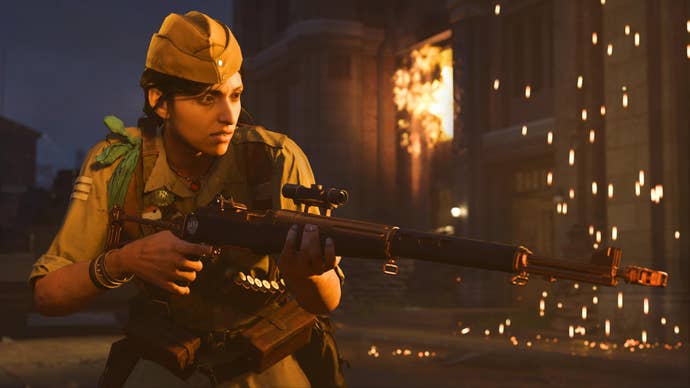
Map design is the biggest departure from Infinity Ward’s game. Where that game’s maps were porous, open and often full of angles impossible for any normal player to adequately cover or account for, Vanguard instead takes a traditional map design approach that brings arcade back into the mix, with predictable lanes, and a few sparse openings that dictate the flow without appearing too manufactured.
There’s an impressive number of maps on day one, too: 16! 20 if you count the Champion Hill maps. I am close to reaching the max level as I write this, and I am constantly being surprised by the sheer environmental variety – pulling from all three major fronts of the war - size, and the experience every one offers.
Vanguard’s big new mechanic initially struck me as a gamble, but I am now convinced it should be in every Call of Duty game going forward. The game offers the traditional multiplayer modes you’d expect, and a couple of new additions. But what’s notable is that it also lets you pick a preferred combat pace. This dictates the number of players in every match. Tactical is the standard Call of Duty pace. Then there’s the faster Assault pace, followed by the rip-roaring Blitz. Sledgehammer previously said that the goal of Blitz was to replicate the experience of playing Shipment – the chaotic small map - on every map in the game. This is done by ramping up the player counts and shortening spawn timers.
Crucially, there’s no set number of players you can expect for each one of these combat paces – the game just picks the right mix appropriate for each map. It doesn’t always get this right, and you’ll occasionally spawn on top of an enemy or in their line of fire, but that’s only really a problem in the smaller maps. It’s fairly impressive how consistent the spawns have been in my experience, having played Blitz almost exclusively.
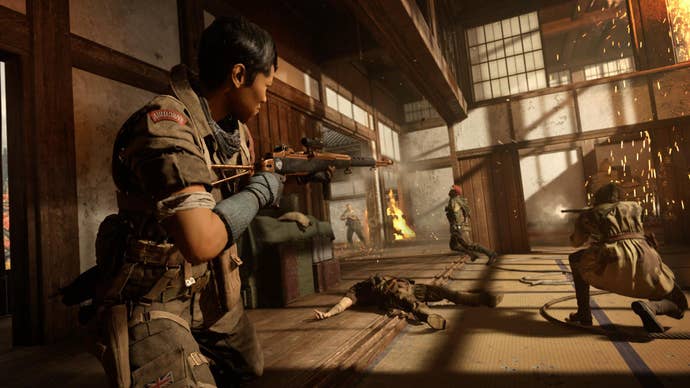
This is exactly what I want from Call of Duty multiplayer. I’ve long since given up on the series outgrowing its simplistic roots and offering a deeper gameplay experience, but I didn’t expect pushing further into the opposite direction to be what actually makes me stick around.
Another interesting addition this year is destruction. It’s not Battlefield-level, by any means, and it manifests in predictable, pre-determined spots – but it’s a neat addition that adds to the chaos. Sure, it’s inevitably going to get old to see these thin wooden walls in every map and know exactly what’s going to happen, but the novelty hasn’t worn off yet.
Outside of these destructible elements, environments in Vanguard are fairly reactive. Debris will fly when a grenade goes off indoors, shattering glassware and cracking tables. This subtle effect is actually the more interesting, even if it’s only really visual.
Zombies
Call of Duty’s yearly co-op side mode is especially notable this year. For one, it’s not actually made by the main game’s developer, Sledgehammer. Instead, Activision brought in Zombies masters Treyarch to create it, and tie it into another game’s story – Black Ops Cold War’s – for the first time.
All of this sounds good on paper, until you actually spend time with the thing. Vanguard Zombies is the most slapped together, rushed, incomplete one of those since the mode’s inception. Without playing this year’s Zombies, you wouldn’t guess that Vanguard had a tumultuous development, considering how polished and present the rest of the package is.
Vanguard Zombies does not have the traditional round-based map, whose various sections must be unlocked as you fend off the undead. It does not have any quests, or so-called Easter eggs of any sort that I could see. There’s no Wonder Weapon – the ultra-powerful mythic firearm that’s typically among the highlights of every new Zombies map - or wall buys.
What we do get is essentially a hub area that’s about a quarter of the size of a typical round-based map. Taking a page from Black Ops Cold War’s Outbreak mode, this map spawns multiple portals which send you to different areas within it, as well as cordoned off sections of the game’s multiplayer maps. Once you’re through the portal, you’ll find one of three basic objectives, and you’re sent back after you’re done to try again.
It is so incredibly barebones it looks like Activision accidentally shipped an in-development build. The field upgrades return from Black Ops Cold War (with a different name), but only four of them made the cut. Even then, you can’t upgrade them in any way. In fact, there is no element of persistent progression in Zombies beyond the traditional XP and weapon XP grind.
Even the Zombies staple mini-game of turning on the power to get the Pack-a-Punch machine is gone. The PaP is on by default, and it only upgrades the rarity of your weapon, meaning there’s only really one upgrade path for weapons here.
As a big fan of Black Ops Cold War’s Outbreak, I am glad the team went with this structure to present whatever meagre morsels of content this year’s Zombies has. But so much is missing here that you’d have to wonder when, or if, it’ll ever become the fully-fledged mode we expect.
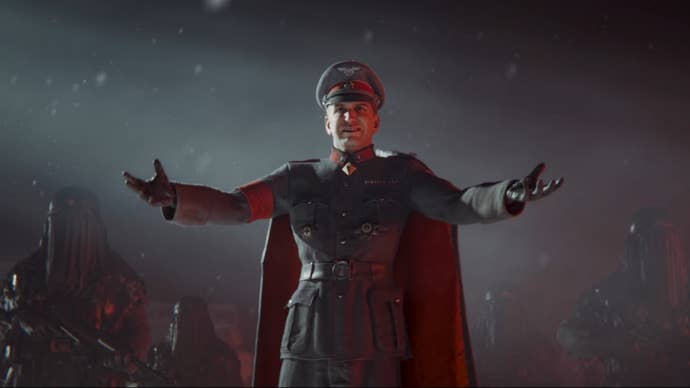
Looming over Vanguard is the unavoidable shadow of publisher Activision Blizzard’s ongoing legal trouble with state and federal agencies for alleged widespread discrimination, sexism, and a history of protecting abusers. It’s hard to remove the game from that context, even if Sledgehammer isn’t itself implicated in those allegations (to our knowledge).
How much all that factors into the decision to buy the game is ultimately yours to make, but what we’ve been learning about Activision Blizzard’s company culture over the past several months certainly sours my own perception of all of its games, Call of Duty included.
Judged on its own merits, Call of Duty: Vanguard offers a solid, albeit predictable campaign, an engaging multiplayer with deep progression systems and satisfying gunplay, and a Zombies mode that will only serve as a minor distraction in its current state.
Version tested: PC. Code provided by publisher. Also available on Xbox One, Xbox Series X|S, PS4, and PS5.
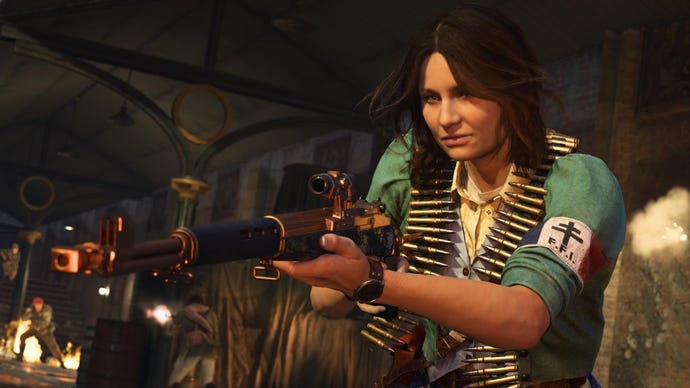

.jpg?width=291&height=164&fit=crop&quality=80&format=jpg&auto=webp)
.jpg?width=291&height=164&fit=crop&quality=80&format=jpg&auto=webp)
.jpg?width=291&height=164&fit=crop&quality=80&format=jpg&auto=webp)
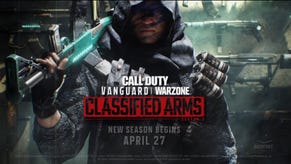

.jpg?width=291&height=164&fit=crop&quality=80&format=jpg&auto=webp)